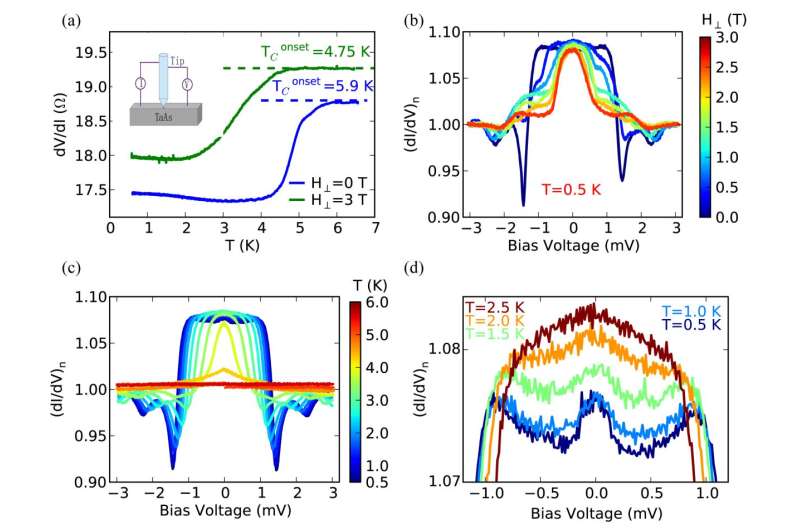Scientists discovered tip induced unconventional superconductivity on Weyl semimetals

Recently, Prof. Jian Wang and collaborators discovered tip-induced unconventional superconductivity by hard point contact on Weyl semi-metal TaAs crystals, which might be topologically non-trivial. Topological superconductors have attracted great attention for their ability to host Majorana zero modes, which could be used in topological quantum computation. Therefore, this discovery not only opens a new route in investigating the novel superconducting states based on Weyl materials, but also demonstrates a new method to induce potential topological superconductivity by hard-point contact modulation on non-superconducting topological materials. This work has been published in Science Bulletin.
Topological superconductors show a superconducting gap in bulk state, but support gapless Majorana fermions or Majorana zero modes in the boundary. The Majorana zero modes obey non-abelian statistics, and can be applied to topological quantum computation and to build a fault-tolerant quantum computer.
In 2016, Prof. Jian Wang in collaboration with Prof. Jian Wei, Prof. Xiong-Jun Liu, Prof. X. C. Xie and Prof. Shuang Jia at Peking University reported unconventional superconductivity induced by hard point contact on 3-D Dirac semi-metal Cd3As2 crystals (Nature Materials 15, 38 (2016)). The results reveal a new way to detect and study potential topological superconductivity by using hard tip/point contact on topological non-trivial materials, which is different from the prevailing proximity effect method for realizing topological superconductivity and Majorana fermions.
The Weyl fermion, a long-sought massless Dirac fermion with definite chirality, has been realized as low-energy excitation around a Weyl point in a Weyl semi-metal, which possesses Weyl fermion cones in the bulk and nontrivial Fermi arc states on the surface. As they are topological Fermi surfaces, Weyl semi-metals could be natural candidates for the realization of topological superconductors if superconductivity can be induced. Recently, Prof. Jian Wang and collaborators reported the discovery of PtIr tip-induced unconventional superconductivity on non-superconducting Weyl semimetal TaAs single crystals.
The point contact spectroscopy exhibits zero bias conductance peak and double conductance peaks, as well as double conductance dips, which reveal the characteristics of unconventional superconductivity. Furthermore, the control experiments show that the W tip can also induce superconductivity but the relatively soft Au tip cannot induce superconductivity on TaAs crystals. It means the local "uniaxial" pressure and doping effect around the point contact region are important to the appearance of superconductivity. Theoretical study further suggests that the induced superconductivity on TaAs may have nontrivial topology. Thus, this work demonstrates an effective method to detect and study topological superconductivity by using hard tip point contact on non-superconducting topological Weyl semimetals.
The researchers also previously studied Au2Pb superconductors by hard point contact measurements. When the "soft" Au tip is used, the superconducting transition temperature obtained by point contact spectroscopy is the same as the result obtained by standard four-electrode measurement. However, when "hard" W tip is used, the superconducting transition temperature obtained by point contact spectroscopy is significantly enhanced. These results further demonstrate that the point contact measurement technique is reliable to induce and detect superconductivity and could become a universal method to realize novel superconductivity on topological non-trivial materials.
Point contact measurement was previously considered in a few cases to study superconducting materials. The present work reports the developed technique to induce superconductivity on non-superconducting topological materials by using non-superconducting tip (hard point contact), different from previous point contact experiments, where the samples are superconductors themselves. Therefore, the present discovery may motivate more investigations to fully reveal the topological superconductivity induced by hard tip on topological materials.
More information: He Wang et al, Discovery of tip induced unconventional superconductivity on Weyl semimetal, Science Bulletin (2017). DOI: 10.1016/j.scib.2017.02.009
Journal information: Nature Materials
Provided by Science China Press





















